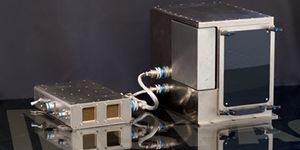
The aging process affects everything from cardiovascular function to memory to sexuality. Most worrisome for many, however, is the potential loss of eyesight because of retinal degeneration.
New progress towards a prosthetic retina could help alleviate conditions that result from problems with this vital part of the eye. An encouraging new study published in Nano Letters describes a novel device, tested on animal-derived retinal models, that has the potential to treat a number of eye diseases. The proof-of-concept artificial retina was developed by an international team led by Prof. Yael Hanein of Tel Aviv University's School of Electrical Engineering and head of TAU's Center for Nanoscience and Nanotechnology and including researchers from TAU, the Hebrew University of Jerusalem and Newcastle University.
"Compared to the technologies tested in the past, this new device is more efficient, more flexible, and can stimulate neurons more effectively," said Prof. Hanein. "The new prosthetic is compact, unlike previous designs that used wires or metals while attempting to sense light. Additionally, the new material is capable of higher spatial resolution, whereas older designs struggled in this area."
The researchers combined semiconductor nanorods and carbon nanotubes to create a wireless, light-sensitive, flexible film that could potentially replace a damaged retina. The researchers tested the new device with chick retinas that were not yet light sensitive to prove that the artificial retina is able to induce neuronal activity in response to light.
Patients with age-related macular degeneration (AMD), which usually affects people age 60 or older who have damage to a specific part of the retina, will stand to benefit from the nanotube device if it is proved compatible in animals over the long term.
According to TAU doctoral student and research team member Dr. Lilach Bareket, there are already medical devices that attempt to treat visual impairment by sending sensory signals to the brain. While scientists are trying different approaches to develop an implant that can "see" light and send visual signals to a person's brain, to counter the effects of AMD and related vision disorders, many of these approaches require the use of metallic parts and cumbersome wiring or result in low resolution images. The researchers set out to make a more compact device.
"In comparison with other technologies, our new material is more durable, flexible, and efficient, as well as better able to stimulate neurons," said Prof. Hanein. "We hope our carbon nanotube and semiconductor nanorod film will serve as a compact replacement for damaged retinas."
"We are still far away from actually replacing the damaged retina," said Dr. Bareket. "But we have now demonstrated that this new material stimulates neurons efficiently and wirelessly with light. If you compare this to other devices based on silicon technology, which require wiring to outside energy or light sources, this is a groundbreaking new direction."
The research team received funding for their study from the Israel Ministry of Science and Technology, the European Research Council and the Biotechnology and Biological Sciences Research Council.
 The aging process affects everything from cardiovascular function to memory to sexuality. Most worrisome for many, however, is the potential loss of eyesight because of retinal degeneration.
The aging process affects everything from cardiovascular function to memory to sexuality. Most worrisome for many, however, is the potential loss of eyesight because of retinal degeneration.







